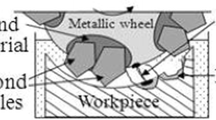Abstract
In this paper, a combined hybrid group method for data handling and optimization approach is introduced to predict burr types formed during face milling. The hybrid group method for data handling (hybrid GMDH) network was constructed for realizing predictive models for the machining of aluminum alloy, and differential evolution was selected for the optimization of burr formation problem resulting in finding optimal parameter for minimizing burr formation. Burr type was included as a parameter resulting in a classification scheme in which the burr type becomes the group label and it is therefore possible in the future to classify a machining process into any of these burr types. The resulting hybrid GMDH output was in agreement with experimental results, thereby validating the proposed scheme for modeling and prediction of burr formation in milling operations.
Similar content being viewed by others
References
Ko SL, Dornfeld DA Analysis and modeling of burr formation and break out in metal. In: Proceedings of the Symposium on Mechanics of deburring and surface finishing processes, ASME Winter Annual Meeting, 1989, pp. 79–92 (American Society of Mechanical Engineers, New York)
Gillespie LK (1979) Deburring precision miniature parts. Precis Eng 1(4):189–198. doi:10.1016/0141-6359(79)90099-0
Lee SH, Lee S (2003) Optimization of cutting parameters for bun minimization in face milling operations. Int Prod Res 41(3):495–511
Chu C, Dornfeld DA Prediction and simulation of milling bun formation for edge-precision process planning. In: Proceedings of the Third International Conference on Integrated design and manufacturing in mechanical engineering, Montreal, Canada, 16–19 May 2000, paper JA27.4 (AIP-PRIMECA, France)
Hassamontr J (1998) Edge finishing planning in milling. PhD Dissertation, University of California, Berkeley
Sokolowski A, Narayanaswami R, Dornfeld DA (1994) Prediction of burr size using neural network and fuzzy logic. In Proceedings of the Japan–USA Symposium on Flexible automation, Kobe, Japan, pp. 889–896 (Institute of Systems, Control and Information Engineers, Tokyo)
Nakayama K, Aral M (1987) Buff formation in metal cutting. Ann CIRP 36(1):33–36. doi:10.1016/S0007-8506(07)62547-5
Kishimuto W, Mlyake T, Yamamato A, Yaniamato K, Takaro IC (1981) Study of burr formation in face milling. Bull Jpn Soc Precis Eng 15(1):51–52
Chern G (1993) Analysis of burr formation and breakout in metal cutting. PhD Dissertation, University of California, Berkeley
Olvera O, Barrow G (1996) An experimental study of bun formation in square shoulder face milling. Int J Mach Tools Manuf 36(9):1005–1020. doi:10.1016/0890-6955(96)00014-4
Olvera O, Barrow G (1998) Influence of exit angle and tool nose geometry on burr formation in face milling Operations. Proc Inst Mech Eng B J Eng Manuf 212:59–72
Hashimura M, Hassamontr J, Dornfeld D (1999) Effect of in-plane exit angle and rake angles on burr height and thickness in face milling operation. J Manuf Sci Eng 121:13–18
Nian CY, Yang YH, Tarng YS (1999) Optimization of turning operations with multiple performance characteristics. J Mater Process Technol 95:1–3, 90–96. doi:10.1016/S0924-0136(99)00271-X
Tseng P-C, Chiou I-C (2003) The burr formation prediction and minimization based on the optimal cutting parameters design method. JSME Int J 46(2):779–787
Karnik SR, Galtonde VN, Davim JP (2007) Integrating Taguchi principle with genetic algorithm to minimize burr size in drilling of AISI 316L stainless steel using an artificial neural network model. Proc Inst Mech Eng B J Eng Manuf 221:1695–1704
Lee SH, Dornfeld DA (2007) Prediction of burr formation during face milling using an artificial neural network with optimized cutting conditions. Proc Inst Mech Eng B J Eng Manuf 221:1705–1714
Lee J, Dornfeld DA (2000) Development of a drilling burr control chart for stainless steel. Trans North Am Manuf Res Inst SME 28:317–322
Min sK, Kim J, Dornfeld UA (2001) Development of a drilling burr control chart for low alloy steel, AISI 4118.1. Mater Process Technol 113(1):4–9
Buryan P, Onwubolu GC (2008) Design of enhanced MIA-GMDH learning networks. Int J Syst Sci (in press)
Onwubolu GC (2007) Design of hybrid differential evolution and group method of data handling for inductive modeling, Proceedings of International Workshop on Inductive Modeling, Prague, Czech, pp 87–95
Onwubolu GC (2008) Design of hybrid differential evolution and group method in data handling networks for modeling and prediction. Information Sciences 178:3618–3634. doi:10.1016/j.ins.2008.05.013
Ivakhnenko AG (1971) Polynomial theory of complex systems. IEEE Trans Syst Man Cybern 1:364–378
Madala HR, Ivakhnenko AG (1994) Inductive learning algorithms for complex systems modeling. CRC, Boca Raton
Storn RM, Price KV, Lampinene JA (2005) Differential evolution: a practical approach to global optimization. Springer, Berlin
Onwubolu GC (2001) Optimisation using differential evolution algorithm, Institute of Applied Science, The University of the South Pacific, Technical Report No. 2001/05
Davendra D, Onwubolu GC (2007) Enhanced differential evolution hybrid scatter search for discrete optimization. IEEE Congress on Evolutionary Computation, Singapore, September 25–28, 2007
Wright PK (1982) Prediction of shear plane angle in machining from work material strain-hardening characteristics. Trans ASME Eng Ind 104(3):285–292
Author information
Authors and Affiliations
Corresponding author
Rights and permissions
About this article
Cite this article
Onwubolu, G.C. Prediction of burr formation during face milling using a hybrid GMDH network model with optimized cutting conditions. Int J Adv Manuf Technol 44, 1083–1093 (2009). https://doi.org/10.1007/s00170-008-1909-3
Received:
Accepted:
Published:
Issue Date:
DOI: https://doi.org/10.1007/s00170-008-1909-3




